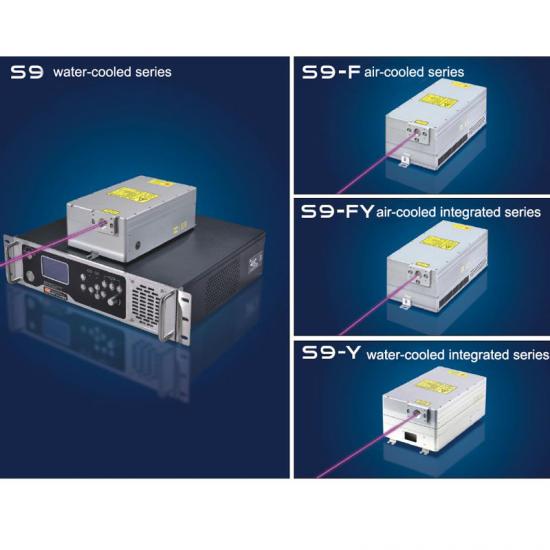Blog más reciente
¿Qué es un láser ultravioleta?
Apr 07 , 2022What is a UV Laser?
UV Laser or Ultraviolet Laser offer extremely high photon energy which opens up a wide range of applications that can’t be addressed by visible and infrared laser sources.
UV lasers use a highly absorptive wavelength (355 nm) to mark parts. This high absorption rate allows UV lasers to perform "cold marking," ensuring that no extra heat stress is applied to materials, including those with high reflectance such as gold, silver, and copper. This minimizes soot and burrs caused by typical marking and processing.
It’s important to point out that while 355 nm and 266 nm are the most common UV laser wavelengths, there are also several other Nd: YAG lines that can be doubled and tripled to produce a wide variety of UV wavelengths. To achieve these higher-order harmonics, the electric field density of the laser must be extremely high, as a result, these lasers are primarily available with q-switched lasers. Continuous-wave (CW) UV laser diodes are also available at 375 nm, with both single-mode and multi-mode beam profiles, and with either free space or fibre-coupled outputs. OEM laser packages and CW laser modules are available for both ultraviolet laser diodes and q-switched lasers.
Apart from real ultraviolet lasers, there are ultraviolet laser sources based on a laser with a longer wavelength (in the visible or near-infrared spectral region) and one or several nonlinear crystals for nonlinear frequency conversion. Some examples:
• The wavelength of 355 nm can be generated by frequency tripling the output of a 1064-nm Nd:YAG or Nd:YVO4 laser.
• 266-nm light is obtained with two subsequent frequency doublers, which in effect quadruple the laser frequency.
• Diode lasers can be equipped with nonlinear frequency conversion stages to produce UV light. For example, one may use a continuous-wave near-infrared laser and apply resonant frequency doubling twice, arriving at wavelengths around 300 nm. A main attraction of this approach is that a wide range of wavelengths is accessible, with no limitations to certain laser lines.

uv laser | green laser | Ultraviolet lasers | uv dpss laser | nanosecond laser | UV laser source | Solid State Lasers
How do UV Lasers Work?
By passing a standard wavelength laser (1064 nm) through a non-linear crystal, the wavelength is reduced to 532 nm. This light is further passed through another crystal, effectively reducing its wavelength to 355 nm. As a result, UV lasers are commonly called third-harmonic generation (THG) lasers.
Ultraviolet lasers need to be made with special ultraviolet optics, having a high optical quality and (particularly for pulsed lasers) a high resistance to UV light. In some cases, the lifetime of a UV laser is limited by the lifetime of the used optical elements such as laser mirrors. For the extreme ultraviolet region, there are sources based on high harmonic generation. Such sources can reach wavelengths down to a few nanometers while still having a table-top format. The average output powers, however, are fairly low.
Advantages of UV Laser
1. En comparación con la luz láser estándar (1064 nm) y la luz láser verde (532 nm), la luz láser UV tiene una tasa de absorción de material notablemente más alta. Esto significa que no es necesario aumentar la potencia para crear marcas muy visibles.
2. Los láseres UV pueden marcar materiales altamente reflectantes como el oro, la plata y el cobre con un mínimo daño por calor gracias a la alta tasa de absorción de la luz UV. Esto minimiza el hollín y las rebabas, evita daños en la superficie y permite un marcado resistente a la corrosión.
Aplicaciones
Los láseres ultravioleta encuentran diversas aplicaciones:
Los láseres ultravioleta pulsados de alta potencia se pueden utilizar para cortar y perforar agujeros pequeños en una variedad de materiales, incluidos los materiales que son transparentes a la luz visible.
Los pulsos UV de alta energía se utilizan para la técnica de espectroscopia de descomposición inducida por láser.
Con energías de pulso mucho más bajas en un haz enfocado con precisión, se puede, por ejemplo, hacer una microdisección de materiales biológicos bajo un microscopio o realizar un análisis de fotoluminiscencia (mediciones de la vida útil de la fluorescencia).
Las fuentes UV de onda continua son necesarias para la microlitografía y la inspección de obleas, por ejemplo, en el contexto de la fabricación de chips semiconductores. Otra aplicación es la espectroscopia UV Raman.
Tanto los láseres UV de onda continua como los pulsados se utilizan para fabricar rejillas de Bragg de fibra.
Algunos métodos de cirugía ocular, en particular la cirugía ocular con láser refractivo de la córnea en forma de LASIK, requieren fuentes de láser UV (a veces incluso UV profundo).
Las fuentes de láser ultravioleta implican algunos riesgos de seguridad especiales, en su mayoría relacionados con los riesgos de daño ocular y cáncer de piel.